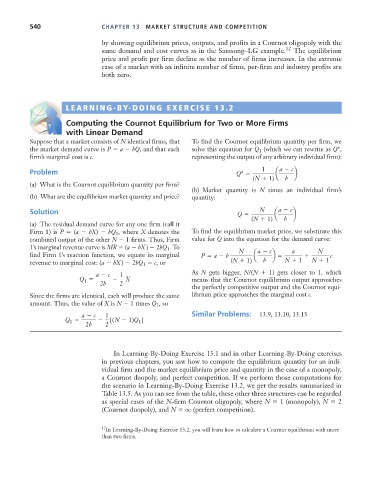Page 566 - Microeconomics, Fourth Edition
P. 566
c13marketstructureandcompetition.qxd 7/30/10 10:44 AM Page 540
540 CHAPTER 13 MARKET STRUCTURE AND COMPETITION
by showing equilibrium prices, outputs, and profits in a Cournot oligopoly with the
same demand and cost curves as in the Samsung–LG example. 12 The equilibrium
price and profit per firm decline as the number of firms increases. In the extreme
case of a market with an infinite number of firms, per-firm and industry profits are
both zero.
LEARNING-BY-DOING EXERCISE 13.2
S
D
E
Computing the Cournot Equilibrium for Two or More Firms
with Linear Demand
Suppose that a market consists of N identical firms, that To find the Cournot equilibrium quantity per firm, we
the market demand curve is P a bQ, and that each solve this equation for Q 1 (which we can rewrite as Q*,
firm’s marginal cost is c. representing the output of any arbitrary individual firm):
1 a c
Problem Q* a b
(N 1) b
(a) What is the Cournot equilibrium quantity per firm?
(b) Market quantity is N times an individual firm’s
(b) What are the equilibrium market quantity and price? quantity:
Solution Q N a a c b
(N 1) b
(a) The residual demand curve for any one firm (call it
Firm 1) is P (a bX) bQ 1 , where X denotes the To find the equilibrium market price, we substitute this
combined output of the other N 1 firms. Thus, Firm value for Q into the equation for the demand curve:
1’s marginal revenue curve is MR (a bX ) 2bQ 1 . To
find Firm 1’s reaction function, we equate its marginal P a b N a a c b a N c
revenue to marginal cost: (a bX ) 2bQ 1 c, or (N 1) b N 1 N 1
a c 1 As N gets bigger, N/(N 1) gets closer to 1, which
Q 1 X means that the Cournot equilibrium output approaches
2b 2
the perfectly competitive output and the Cournot equi-
Since the firms are identical, each will produce the same librium price approaches the marginal cost c.
amount. Thus, the value of X is N 1 times Q 1 , so
a c 1 Similar Problems: 13.9, 13.10, 13.13
Q 1 [(N 1)Q 1 ]
2b 2
In Learning-By-Doing Exercise 13.1 and in other Learning-By-Doing exercises
in previous chapters, you saw how to compute the equilibrium quantity for an indi-
vidual firm and the market equilibrium price and quantity in the case of a monopoly,
a Cournot duopoly, and perfect competition. If we perform those computations for
the scenario in Learning-By-Doing Exercise 13.2, we get the results summarized in
Table 13.5. As you can see from the table, these other three structures can be regarded
as special cases of the N-firm Cournot oligopoly, where N 1 (monopoly), N 2
(Cournot duopoly), and N q (perfect competition).
12 In Learning-By-Doing Exercise 13.2, you will learn how to calculate a Cournot equilibrium with more
than two firms.

